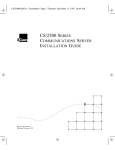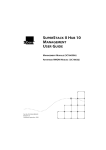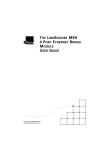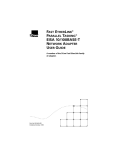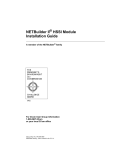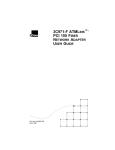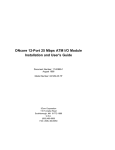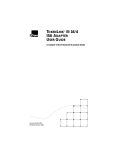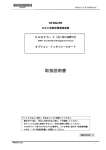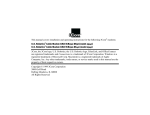Download 3Com 3C16021 Power Supply User Manual
Transcript
® SUPERSTACK II UPS MANAGEMENT MODULE USER GUIDE (3C16020 AND 3C16021) 3Com Corporation ■ 5400 Bayfront Plaza ■ Santa Clara, California ■ 95052-8145 © 3Com Ireland 1996. All rights reserved. No part of this documentation may be reproduced in any form or by any means or used to make any derivative work (such as translation, transformation, or adaptation) without permission from 3Com Ireland. 3Com Ireland reserves the right to revise this documentation and to make changes in content from time to time without obligation on the part of 3Com Ireland to provide notification of such revision or change. 3Com Ireland provides this documentation without warranty of any kind, either implied or expressed, including, but not limited to, the implied warranties of merchantability and fitness for a particular purpose. 3Com may make improvements or changes in the products(s) and/or the program(s) described in this documentation at any time. UNITED STATES GOVERNMENT LEGENDS: If you are a United States government agency, the documentation and software described herein are provided to you subject to the following restricted rights: For units of the Department of Defense: Restricted Rights Legend: Use, duplication or disclosure by the Government is subject to restrictions as set forth in subparagraph (c) (1) (ii) for restricted Rights in Technical Data and Computer Software clause at 48 C.F.R. 52.223 7013. 3Com Ireland c/o 3Com Limited, ISOLAN HOUSE, Brindley Way, Hemel Hempstead, Herts, HP3 9XJ UK. For civilian agencies: Restricted Rights Legend: Use, reproduction or disclosure is subject to restrictions set forth in subparagraph (a) through (d) of the Commercial Computer Software — Restricted Rights Clause at 48 C.F.R. 52.227.19 and the limitations set forth in 3Com’s standard commercial agreement for the software. Unpublished rights reserved under the copyright laws of the United States. 3Com is a registered trademark of 3Com Corporation. Registered trademarks are registered in the United States and may or may not be registered in other countries. SuperStack and 3TECH are trademarks of 3Com Corporation. 3ComFacts and Ask3Com are service marks of 3Com Corporation. Unless otherwise indicated, 3Com registered trademarks are registered in the United States and may or may not be registered in other countries. CompuServe is a registered trademark of CompuServe, Inc. Other brand and product names may be registered trademarks or trademarks of their respective holders. CONTENTS ABOUT THIS GUIDE Introduction vii Conventions vii INTRODUCTION Networking Terminology 1-1 INSTALLATION The SuperStack II UPS Management Module 2-1 Before You Start 2-2 Installing the Management Module 2-2 CONFIGURING THE M ANAGEMENT MODULE Before You Start 3-1 Local Configuration 3-1 Using the Configuration Screens 3-2 Changing the Configuration Fields 3-3 IP address (IP) 3-3 Netmask (NM) 3-4 Gateway (GW) 3-4 Token Ring Network Speed (RS) 3-4 BOOTP retries (BR) 3-5 Authorized Password (PW) 3-5 Command Security Level (LV) 3-5 UPS Unit ID (ID) 3-6 Get-community name (CG) 3-6 Set-community name (CS) 3-6 Trap Community name (CT) 3-6 sysName (SN) 3-7 sysContact (SC) 3-7 sysLocation (SL) 3-7 Attached Devices (AD) 3-7 Host Table Setup Screen 3-8 IP Address (HI) 3-9 Delete Entry (DE) 3-9 Ping (PI) 3-9 Trap Level (TL) 3-9 Trap Type (TT) 3-10 CONNECTING TO THE NETWORK Ethernet Model 4-1 Token-Ring Model 4-1 Exiting the Configuration Program 4-1 TECHNICAL SPECIFICATIONS Standards A-1 Physical Properties Serial Port Pin Out A-1 A-1 TROUBLESHOOTING TECHNICAL SUPPORT On-line Technical Services C-1 3Com Bulletin Board Service C-1 World Wide Web Site C-2 ThreeComForum on CompuServe C-2 3ComFacts Automated Fax Service C-2 Support from Your Network Supplier C-3 Support from 3Com C-4 Returning Products for Repair C-4 ELECTRO-MAGNETIC COMPATABILITY STATEMENTS Federal Communications Commission Radio and Television Interference Statement for Class B Devices CSA STATEMENT VCCI STATEMENT LIMITED WARRANTY ABOUT THIS GUIDE Introduction This guide describes how to install and use the SuperStack ° II UPS Management Module. Each procedure is outlined in a series of steps. These procedures are written primarily for network supervisors who are responsible for installing and configuring the Management Module. You should also be familiar with PC hardware and software and have a basic understanding of your network. Your network should be set up and operating properly. Conventions The icon conventions that are used in this guide are: Icon Type Description Information Note Information notes call attention to important features or instructions. Caution Cautions alert you to system damage or loss of data. Warning Warnings alert you to the risk of severe personal injury. Avertissement Les avertissements vous préviennent qu’il existe un risque de blessure grave. Warnung Warnhinweise sollen Sie auf mögliche schwere Körperverletzungen aufmerksam machen. vi ABOUT THIS GUIDE The text conventions that are used in this guide are: Convention Description “Enter” vs. “Type” When the word “enter” is used in this guide, it means to type something, then press the Return or Enter key. Do not press the Return or Enter key when an instruction simply says “type.” Text represented as screen display This typeface is used to represent displays that appear on your screen, for example: Enter the IP address: Text represented as commands This typeface is used to represent commands that you enter, for example: IP 191.0.0.172 Keys When specific keys are referred to in the text, they are shown as [Enter] or [Return]. Italics Italics are used to denote new terms or emphasis. 1 INTRODUCTION In the modern business environment, communication and sharing information is crucial. With computer networks becoming larger and more complex, a constant power supply is vital to the operation of our organization. Your computer system relies on the battery backup of an Uninterruptible Power System (UPS) to maintain network integrity when the main power source fails. The SuperStack II UPS Management Module provides network power management through UPS monitoring and control. The Management Module is shipped with default settings that you can change to meet the needs of your organization. Networking Terminology A Network is a collection of workstations (for example, BM-compatible personal computers) and other equipment (for example, printers), connected for the purpose of exchanging information. Networks vary in size, some are within a single room, others span continents. Ethernet is a type of local area network, referring to the technology used to pass information around the network. 10BASE-T is the name given to the Ethernet protocol that runs over Unshielded Twisted-Pair (UTP) cable. The Management Module uses an RJ-45 connector for connecting your network. Token Ring is the name given to a network that uses token passing technology in a sequential manner. Token Ring networks use unshielded twisted-pair (UTP) cable or Shielded Twisted-Pair (STP) cable. The Management Module uses either an RJ-45 connector or a 9-pin connector for connecting your network. 1-2 CHAPTER 1: INTRODUCTION Simple Network Management Protocol (SNMP) is a protocol that controls how a management station gains information from a device. SNMP is composed of three areas: ■ A set of rules that define how a management station can communicate with a device. ■ A Management Information Base (MIB) that defines what information can be obtained from the device by the management station. Every SNMP-manageable device has a MIB, which is a list of information about it. ■ Unsolicited messages called Traps, which work differently to the usual request/reply management communication. You can configure a device so that it generates a trap if a certain condition occurs, for example a port partitioning. The trap will be sent to the management station to inform it of the occurrence. Device is a term that is used to refer to a piece of network equipment. Every device has a unique address that is used to identify it on the network. Internet Protocol (IP) is a data communication protocol used to connect computers and data equipment into computer networks. It is used on a large international network called the Internet, which is composed of universities, government facilities, research institutions, and private companies. DUA1602-0AAA01 2 INSTALLATION This chapter describes the SuperStack II UPS Management Module and how to install the module in the SuperStack II UPS. The SuperStack II UPS Management Module The Management Module is a single box that connects to the SuperStack II UPS directly through the management power connector. The Management Module is available in two different models: Ethernet (3C16020) and Token Ring (3C16021). The Ethernet model can connect to a twisted-pair Ethernet (10base-T) network using an RJ-45 connector. With the Token-Ring model, you can connect the Management Module to a shielded or unshielded twisted-pair Token Ring at 4 Mbps or 16 Mbps. The module contains a full SNMP agent that implements the Internet standard (RFC-1628) UPS Management Information Base, private extensions for more control, and relevant portions of MIB II. WARNING: The RJ-45 connector is a data socket. Only data cables should be connected to it. Do not connect telephone outlets to these connectors. AVERTISSEMENT: Le connecteur RJ-45 est une prise de données. Seuls des âbles de données devraient y être connectés. Ne reliez pas de prises téléphoniques à ces connecteurs. WARNUNG: Bei dem Anschluß RJ-45 handelt es sich um eine Datenbuchse, an die ausschließlich Datenleitungen angeschlossen 2-2 CHAPTER 2: INSTALLATION werden dürfen. Schließen Sie keine Telefonanschlüsse an diese Buchsen an. Figure 2-1 Ethernet Model Connections Figure 2-2 Token-Ring Model Connections DUA1602-0AAA01 Before You Start 2-3 Before You Start You must have a SuperStack II UPS installed and operating to use the Management Module, in addition to one of the following cables: ■ Twisted-pair cable for an Ethernet network ■ The patch cable (STP or UTP) for your Token Ring network type Installing the Management Module To install the Management Module, you need access to the management power connector on the UPS and the cables that are connected to your network. 1 Remove the blanking plate on the SuperStack II UPS rear panel. Retain the screws. . Figure 2-3 Removing the Blanking Plate on the SuperStack II UPS 2 Slide the Management Module into the open slot and secure with the blanking plate screws. Make sure the RJ-45 connector is located at the bottom of the Management Module. DUA1602-0AAA01 2-4 CHAPTER 2: INSTALLATION Figure 2-4 Sliding the Module into the UPS 3 Connect the male end of the management power cable (provided with the module) into the management power connector on the back panel of the UPS. Connect the other end of the cable to the management power connector on the Management Module labeled “UPS.” Tighten the screws on the cable connectors to ensure a good connection. Figure 2-5 Connecting the Power Cable DUA1602-0AAA01 CONFIGURING THE MANAGEMENT MODULE 3 You must configure the SuperStack II UPS Management Module before you can use it. The Management Module has a configuration program that you can access by connecting the module to a terminal or a computer with a terminal emulation program. Before You Start Make sure you contact your network administrator for the following values: IP address, Netmask (subnet mask), and Default Gateway. For the Token-Ring model, you also need the operating speed of the Token-Ring network (4 Mbps or 16 Mbps). Write these values down for future reference. To use the configuration screens for the Management Module, you need: ■ A serial cable (see Appendix A) ■ A terminal with an RS-232 serial port, or a PC with a terminal emulation program such as Windows Terminal® The serial line should be set to 9600 baud, No parity, 8 bits, and 1 stop bit. The configuration program always runs at these settings. Local Configuration To connect the module to the terminal and start the configuration program: 1 Plug the male end of the serial cable into the serial port labeled “TERM.” 3-2 CHAPTER 3: CONFIGURING THE MANAGEMENT MODULE 2 Plug the other end of the serial cable into the serial port on the back of the terminal. 3 Press [Return]. The Main Configuration screen for the module type appears (“Figure 3-1 Main Configuration Screen for Ethernet” or “Figure 3-2 Main Configuration Screen for Token Ring”). If the Main Configuration screen does not appear, press [Return] and make sure the Management Module is properly connected to the UPS (see “Installing the Management Module”). If you still do not see the Main Configuration screen, check the following conditions: ■ Check the communications settings of the terminal you are using. It should be set to 9600 baud, No parity, 8 bits, and 1 stop bit. ■ If the serial configuration is correct, check the cable between the module and terminal to be sure all connections are secure. ■ Make sure your terminal program is on the correct communications port for your RS-232 connection. ■ Verify that the management power cable is connected to the UPS. Using the Configuration Screens Each version of the Management Module has its own configuration screen. When you start the configuration program, the Main Configuration screen for your module appears. Figure 3-1 shows the screen for the Ethernet module. Figure 3-2 shows the screen for the Token-Ring module. The Main Configuration screen shows the current configuration settings for your Management Module. A list of command (CMD) options are available in the left column of the screen. DUA1602-0AAA01 Changing the Configuration Fields 3-3 Figure 3-1 Main Configuration Screen for Ethernet Figure 3-2 Main Configuration Screen for Token Ring Changing the Configuration Fields The first fields you must configure are IP address, Netmask and Default Gateway, and for Token Ring, Ring Speed. In addition, configure the Token Ring Network Speed for the Token-Ring model. You should also add a host to receive traps (see “Trap Level (TL)”). To change the value of a setup option, enter the two letter command followed by the new value. For example, to change the DUA1602-0AAA01‘ 3-4 CHAPTER 3: CONFIGURING THE MANAGEMENT MODULE IP address, type: IP a.b.c.d where a, b, c, and d are numbers between 0 and 255. The new values do not appear until you press [Enter] on a blank command line to redisplay the screen. If you enter a command without a new value, the existing value for that option appears. If you enter an invalid value, the screen displays a range of valid values. You can refresh the Main Configuration screen to show your changes by typing CF and pressing [Enter]. The configuration settings you can change are described in the following sections. IP address (IP) Type IP followed by a space and the Internet address assigned to the Management Module to change the IP address. Use the format a.b.c.d, where a, b, c, and d are numbers between 0 and 255. If you type a number that is not in this range, an error message appears. If you do not know the IP address to use, contact your network administrator. Press [Enter] to save the new setting and return to the configuration screen. Netmask (NM) Type NM followed by a space and the Netmask value to change the netmask value. Use the format a.b.c.d, where a, b, c, and d are numbers between 0 and 255. If you type a number that is not in this range, an error message appears. If your local network is partitioned into subnets, be sure to set this value to show that (for example, 255.255.0.0). DUA1602-0AAA01 Changing the Configuration Fields 3-5 If you do not know the Netmask value to use, contact your network administrator. Press [Enter] to save the new setting and return to the configuration screen. Gateway (GW) To change the default gateway, type GW followed by a space and the default gateway. The default gateway is the default destination for all packets not addressed to the local network segment. This value must be set if you have routers in your network. Use the format a.b.c.d, where a, b, c, and d are numbers between 0 and 255. If you type a number that is not in this range, an error message appears. If there is not a primary gateway, type GW 0.0.0.0. If you do not know the default gateway, contact your network administrator. Press [Enter] to save the new setting and return to the configuration screen. Token Ring Network Speed (RS) (Token-Ring model only) Type RS followed by a space and the speed (in Mbps) of your Token-Ring network. Type 4 for a 4-Mbps Token Ring, or 16 for a 16-Mbps Token Ring. The default speed is 16 Mbps. Press [Enter] to save the new setting and return to the configuration screen. DUA1602-0AAA01‘ 3-6 CHAPTER 3: CONFIGURING THE MANAGEMENT MODULE BOOTP retries (BR) Type BR followed by a space and the number of times the Management Module should request BOOTP configuration. You can specify any positive number up to 255 (the default is 30). If you set this field to 0, no BOOTP requests are made. To have the module request BOOTP configuration repeatedly until it receives a successful configuration, specify –1 in this field. Retries are sent at approximately two-minute intervals. Press [Enter] to save the new setting and return to the configuration screen. Be sure to set this field to 0 if your network does not have a BOOTP server. If you specify any other value, you have to wait while the Management Module powers on and receives a successful BOOTP configuration (or completes the specified number of requests). Authorized Password (PW) This field is reserved for future use. Command Security Level (LV) To change the command security level, type LV followed by a space and the corresponding level number. This command determines who receives data or sends commands. There are three possible entries: 1, 2, or 3. 1 The standard level allows anyone with the correct community name (for SNMP) to receive data or send commands. The standard level is the default. DUA1602-0AAA01 Changing the Configuration Fields 2 The high-sets level restricts sets and commands to those hosts that appear in the host table; any SNMP manager with the correct get-community name may request data. 3 The high level is the most secure. Only those hosts who appear in the host table and users with the correct community name can receive data or send commands. 3-7 Press [Enter] to save the new setting and return to the configuration screen. UPS Unit ID (ID) To change the UPS Unit ID field type ID followed by a space and the “name of the UPS unit“ that you are currently configuring. You must use quotes to enclose the UPS unit name. You can enter up to 16 characters to identify the UPS unit. Press [Enter] to save the new setting and return to the configuration screen. Get-community name (CG) To change the community name, type CG followed by a space and the community name. This command changes the community name hat the SNMP manager can use when performing a get operation, but not set operations. Type up to 16 alphanumeric characters to specify the get-community name. This field is case-sensitive and cannot contain blanks. Make sure the get-community name is different than the set-community name to avoid conflicts with set operations. Press [Enter] to save the new setting and return to the configuration screen. DUA1602-0AAA01‘ 3-8 CHAPTER 3: CONFIGURING THE MANAGEMENT MODULE Set-community name (CS) Type CS followed by a space and the community name to change the community name the SNMP manager uses when performing set or get operations. Type up to 16 alphanumeric characters to specify the set-community name. This field is case-sensitive and cannot contain blanks. Press [Enter] to save the new setting and return to the configuration screen. Trap Community name (CT) Type CT followed by a space and the community name to change the community name that is sent along with the traps to your network manager. Type up to 16 alphanumeric characters to specify the trap community name. This field is case-sensitive and cannot contain blanks. Press [Enter] to save the new setting and return to the configuration screen. sysName (SN) To change the system name field type SN followed by a space and the “system name“. You must use quotes to enclose the system name. Type the system name assigned by your system administrator (up to 63 alphanumeric characters). The name you enter is used by network operators, and is not used for network addressing. (If you do not specify a system name here, you can do so using your SNMP management application.) Press [Enter] to save the new setting and return to the configuration screen. DUA1602-0AAA01 Changing the Configuration Fields 3-9 sysContact (SC) Type SC followed by a space and the “system contact name“ to change this field. You must use quotes to enclose the system contact name. Type up to 63 alphanumeric characters to identify someone to contact with questions about this device. For example, you can type a person’s name, phone number, department, or physical location. (If you do not specify a system contact here, you can do so using your SNMP management application.) Press [Enter] to save the new setting and return to the configuration screen. sysLocation (SL) Type SL followed by a space and the “system location name“ to change this field. You must use quotes to enclose the system location. Type up to 63 alphanumeric characters to identify the location of the installed Management Module. Press [Enter] to save the new setting and return to the configuration screen. Attached Devices (AD) To list the protected equipment currently connected to the UPS, type AD followed by a space and the “device name“. You must use quotes to enclose the attached devices. Type up to 63 characters (for device names) to identify other SuperStack devices, such as hubs and switches, that are connected to the UPS. Press [Enter] to save the new setting and return to the configuration screen. DUA1602-0AAA01‘ 3-10 CHAPTER 3: CONFIGURING THE MANAGEMENT MODULE Host Table Setup Screen The Host Table Setup screen allows you to add hosts permanently to the Management Module’s Host Table. The host table automatically adds hosts as nonpermanent entries when host communication is established with the Management Module. This command must be used if you want to receive traps. To access this screen from the Main Configuration screen, type HS and press [Return]. The Host Table Setup screen appears (Figure 3-3). Figure 3-3 Host Table Setup Screen The Host Table Setup screen displays the host access list and the current setting for each host. The host number (Host Num) appears in the left column of the screen. To change a value of a host field, type the two letter command for a specific host number. For example, to change the IP address, type: HI n a.b.c.d where n equals the host number and a, b, c, and d are numbers between 0 and 255. You can change the following settings in the Host Table Setup screen: DUA1602-0AAA01 Host Table Setup Screen 3-11 IP Address (HI) Type HI and the host number followed by a space and the IP address of the host entry that you want to modify. Use the format a.b.c.d, where a, b, c, and d are numbers between 0 and 255. If you type a number that is not in this range, an error message appears. Press [Return] to save the new setting and return to the host access list. Delete Entry (DE) To remove a configured host, you can change its IP address to a new value, if one exists. Otherwise, use the Delete Entry command. To delete the entry, type DE and the host number and press [Return]. Only eight hosts can be stored in the permanent memory. Ping (PI) The Ping option verifies the host’s physical address. If you are connected to the network, you can use the Ping function to verify a host’s address. Type PI and the host number followed by a space and the IP address. Press [Return] to send the command. If the ping is successful, the Management Module responds with the following message: ping Successful: Round Trip Time=xx.xx sec If the ping is unsuccessful, the module displays an error message. Trap Level (TL) To set the trap level, type TL and the host number followed by a space and the trap level. The possible values for the trap level are: DUA1602-0AAA01‘ 3-12 CHAPTER 3: CONFIGURING THE MANAGEMENT MODULE 0 None), hosts do not receive any traps 1 Critical), hosts receive only severe traps 2 Major), hosts receive severe and serious traps 3 (All), to receive all traps Press [Return] to save the new setting and return to the host access list. The default setting for this field is 0 (None). Trap Type (TT) To set the trap type, type TT and the host number followed by a space and the trap type. The Management Module provides four possible trap types. 1 (Stnd MIB), hosts receive UPS Standard MIB-defined traps 2 Private MIB), hosts receive PrivateMIB-defined traps 3 Stnd+msgs), hosts receive UPS Standard MIB traps plus additional information 4 Private+msgs), hosts receive PrivateMIB traps plus additional messages Press [Return] to save the new setting and return to the host access list. The default setting for this field is 1 (Stnd MIB). DUA1602-0AAA01 4 CONNECTING TO THE NETWORK Be sure you have the appropriate cables and connectors as described in “Before You Start” on page 2-3. Ethernet Model To connect an Ethernet Management Module to the network: 1 Plug one end of a twisted-pair cable into the RJ-45 port on the Management Module. 2 Plug the other end into an appropriate port on your network device. Token-Ring Model For a Token-Ring network, you need the appropriate cable to connect to your network type. To connect a Token-Ring Management Module to the network: 1 Plug one end of the network cable into the Management Module. For a shielded twisted-pair network, plug the 9-pin connector into the 9-pin jack on the Management Module. Tighten the screws on the connector to ensure a good connection. For an unshielded twisted-pair network, plug one end of the cable into the RJ-45 port on the Management Module. 2 Plug the other end of the network cable into an appropriate port on your Token-Ring device. 4-2 CHAPTER 4: CONNECTING TO THE NETWORK Exiting the Configuration Program To save your configuration, type SA and press [Return]. This command saves the changes entered in the Main Configuration screen and restarts the Management Module. Your SuperStack II UPS Management Module is now configured. Disconnect the terminal from your Management Module. DUA1602-0AAA01 TECHNICAL SPECIFICATIONS A Standards The SuperStack II UPS Management Module has been designed to comply with the following standards: Safety UL 1950 CSA C22.2-950 EN 60950 EMC EN 55022 Class B FCC Part 15 Class B CSA C108-8 Class B EN 50082-2 Environmental EN 60068 Physical Properties Physical Specifications Width 11.8 cm (4.63 in) Height 3.2 cm (1.25 in) Depth 16 cm (6.25 in) Weight 373 g (0.821 lb) Operating Environment: 0-90% (noncondensing) humidity Operating Temperature: 0-40°C (32-105°F) A-2 APPENDIX A: TECHNICAL SPECIFICATIONS Serial Port Pin Out Figure A-1 Serial Port Numbering Only three links should be made. Other pin definitions are for information only, and are not supported. Figure A-2 Serial Port Cabling (Module to PC/Terminal) DUA1602-0AAA01 TROUBLESHOOTING B Use the following troubleshooting chart to help you solve any problems that may occur with the SuperStack II UPS Management Module. Table B-1 Troubleshooting Chart Problem Possible Cause Corrective Action Management Module does not respond to SNMP get requests, but does respond to pings. Wrong community name being used. The get-community name that was set during the module configuration does not match the one being used by your network management system (NMS) for get requests. To verify that the community name is mismatched, connect a terminal to the module (see “Local Configuration”on page 3-2). If the authentication failed, SNMP source: x.x.x.x:y message appears (where x.x.x.x is the IP address of your NMS) every time your NMS does an SNMP get request, then correct the get-community name used by the NMS. Note that community names are case-sensitive, and non-alphanumeric characters (such as spaces) are included in the count. Please refer to your NMS user’s guide for more information on configuring community names. The Management Module does not initialize and “open” onto the Token Ring. Bad cable connection. Incorrect ring speed configured in the Management Module. Verify cable connections at Management Module and at the concentrator. Verify the proper ring speed with the network administrator, and configure the Management Module for that speed. B-2 APPENDIX B: TROUBLESHOOTING The Token Ring stops functioning when the Management Module powers up and starts connecting to the Token Ring. Incorrect ring speed configured in the Management Module. Verify the proper ring speed with the network administrator, and configure the Management Module for that speed. Using the same community name for SNMP gets and sets; gets work, but sets do not. The same community name is used for both gets and sets. Make sure the get-community name and set-community name are different. You can use the set-community name for doing both gets and sets. If you want to use just one community name (such as public) for gets and sets, then configure the Management Module’s get-community name to some value you are not using (such as unused) and configure its set-community name to the desired value (public). DUA1602-0AAA01 TECHNICAL SUPPORT C 3Com provides easy access to technical support information through a variety of services. This appendix describes these services. On-line Technical Services 3Com offers worldwide product support seven days a week, 24 hours a day, through the following on-line systems: ■ 3Com Bulletin Board Service (3ComBBS) ■ World Wide Web site ■ ThreeComForum on CompuServe® ■ 3ComFacts SM automated fax service 3Com Bulletin Board Service 3ComBBS contains patches, software, and drivers for all 3Com products, as well as technical articles. This service is available via modem or ISDN seven days a week, 24 hours a day. Access by Modem To reach the service by modem, set your modem to No parity, 8 bits, and 1 stop bit. Call the telephone number nearest you: Country Data Rate Telephone Number Australia up to 14400 bps (61) (2) 9955 2073 France up to 14400 bps (33) (1) 69 86 69 54 Germany up to 9600 bps up to 9600 bps (49) (89) 627 32 188 (49) (89) 627 32 189 C-2 APPENDIX C: TECHNICAL SUPPORT Hong Kong up to 14400 bps (852) 537 5608 Italy (fee required) up to 14400 bps (39) (2) 273 00680 Japan up to 14400 bps (81) (3) 3345 7266 Singapore up to 14400 bps (65) 534 5693 Taiwan up to 14400 bps (886) (2) 377 5838 U.K. up to 28800 bps (44) (1442) 278278 U.S. up to 28800 bps (1) (408) 980 8204 Access by ISDN ISDN users can dial-in to 3ComBBS using a digital modem for fast access up to 56 Kbps. To access 3ComBBS using ISDN, dial the following number: (408) 654-2703 World Wide Web Site Access the latest networking information on 3Com’s World Wide Web site by entering our URL into your internet browser: http://www.3Com.com/ This service features news and information about 3Com products, customer service and support, 3Com’s latest news releases, selected articles from 3TECH ä (3Com’s award-winning technical journal), and more. ThreeComForum on CompuServe ThreeComForum is a CompuServe-based service containing patches, software, drivers, and technical articles about all 3Com products, as well as an interactive forum for technical questions. To use ThreeComForum, you need a CompuServe account. To use ThreeComForum: 1 Log on to CompuServe. DUA1602-0AAA01 3ComFacts Automated Fax Service C-3 2 Enter go threecom. 3 Press [Return] to see the Ask3Com SM main menu. 3ComFacts Automated Fax Service 3Com Corporation’s interactive fax service, 3ComFacts, provides data sheets, technical articles, diagrams, and troubleshooting instructions on 3Com products 24 hours a day, seven days a week. Call 3ComFacts using your touch-tone telephone. International access numbers are: Country Fax Number Hong Kong (852) 2537 5610 U.K. (44) (1442) 278279 U.S. (1) (408) 727 7021 Local access numbers are available within the following countries: Country Fax Number Country Fax Number Australia 800 123853 Netherlands 06 0228049 Belgium 0800 71279 Norway 800 11062 Denmark 800 17319 Portugal 0505 442607 Finland 98 001 4444 Russia (Moscow only) 956 0815 France 05 90 81 58 Spain 900 964445 Germany 0130 8180 63 Sweden 020 792954 Italy 1678 99085 U.K. 0800 626403 Support from Your Network Supplier If additional assistance is required, contact your network supplier. Many suppliers are authorized 3Com service partners who are DUA1602-0AAA01 C-4 APPENDIX C: TECHNICAL SUPPORT qualified to provide a variety of services, including network planning, installation, hardware maintenance, application training, and support services. When you contact your network supplier for assistance, have the following information ready: ■ Diagnostic error messages ■ A list of system hardware and software, including revision levels ■ Details about recent configuration changes, if applicable If you are unable to contact your network supplier, see the following section on how to contact 3Com. Support from 3Com If you are unable to receive support from your network supplier, technical support contracts are available from 3Com. In the U.S. and Canada, call (800) 876-3266 for customer service. If you are outside the U.S. and Canada, contact your local 3Com sales office to find your authorized service provider: Country Telephone Number Country Telephone Number Australia (Sydney) (Melbourne) (61) (2) 959 3020 (61) (3) 653 9515 Japan (81) (3) 3345 7251 Mexico (525) 531 0591 Belgium* 0800 71429 Netherlands * 06 0227788 Brazil (55) (11) 546 0869 Norway* 800 13376 Canada (416) 498 3266 Singapore (65) 538 9368 Denmark* 800 17309 South Africa (27) (11) 803 7404 Finland* 0800 113153 Spain* (34) (1) 3831700 France* 05 917959 Sweden* (45) (8) 632 91 00 Germany* 0130 821502 Taiwan (886) (2) 577 4352 DUA1602-0AAA01 Returning Products for Repair Hong Kong (852) 868 9111 United Arab Emirates (971) (4) 349049 Ireland* 1 800 553117 U.K.* 0800 966197 Italy* 1678 79489 U.S. (1) (408) 492 1790 C-5 *These numbers are toll-free Returning Products for Repair A product sent directly to 3Com for repair must first be assigned a Return Materials Authorization (RMA) number. A product sent to 3Com without an RMA number will be returned to the sender unopened, at the sender’s expense. To obtain an RMA number, call or fax: DUA1602-0AAA01 Country Telephone Number Fax Number U.S. and Canada (800) 876 3266 option 2 Europe 31 30 60 29900 option 5 Outside Europe, U.S. and Canada (1) (408) 492 1790 (1) (408) 764 7290 C-6 APPENDIX C: TECHNICAL SUPPORT DUA1602-0AAA01 ELECTRO-MAGNETIC COMPATABILITY STATEMENTS Federal Communications Commission Radio and Television Interference Statement for Class B Devices This equipment has been tested and found to comply with the limits for Class B digital devices, pursuant to part 15 of the FCC Rules. These limits are designed to provide reasonable protection against harmful interference in a residential installation. This equipment generates, uses, and can radiate radio frequency energy and, if not installed and used in accordance with the instructions, may cause harmful interference to radio communications. However, there is no guarantee that interference will not occur in a particular installation. If this equipment does cause harmful interference to radio or television reception, which can be determined by turning the equipment off and on, the user is encouraged to try to correct the interference by one of the following measures. User Instructions: ■ Reorient or relocate the receiving antenna. ■ Increase the separation between the equipment and receiver. ■ Connect the equipment into an outlet on a circuit different from that to which the receiver is connected. ■ Ensure that card mounting screws, connector attachment screws and all ground wires are secured and tight. ■ Consult the dealer or an experienced radio/TV technician for help. Changes or modifications not expressly approved by the party responsible for compliance could void the user’s authority to operate the equipment. This product was FCC certified under test conditions that included the use of shielded I/O cable and connectors between system components. To be in compliance with FCC regulations, the user must use shielded cables and connectors and install them properly. CSA STATEMENT This Class B digital apparatus meets all requirements of the Canadian Interference-Causing Equipment Regulations. Cet appareil numérique de la classe B respecte toutes les exigences du Règlement sur le matériel brouilleur du Canada. VCCI STATEMENT Limited Warranty HARDWARE: 3Com warrants its hardware products to be free from defects in workmanship and materials, under normal use and service, for the following lengths of time from the date of purchase from 3Com or its Authorized Reseller. Internetworking products One Year Network adapters Lifetime Ethernet stackable hubs and Unmanaged Ethernet fixed port repeaters *Power supply and fans in these stackable hubs and unmanaged repeaters Lifetime* (One year if not registered) One Year Other hardware products One Year Spare parts and spares kits 90 days If a product does not operate as warranted during the applicable warranty period, 3Com shall, at its expense, correct any such defect by repairing the defective product or part or, at its option, by delivering to Customer an equivalent product or part to replace the defective item. All products that are replaced will become the property of 3Com. Replacement products may be new or reconditioned. Any replaced or repaired product or part has a ninety (90) day warranty or the remainder of the initial warranty period, whichever is longer. 3Com shall not be responsible for any software, firmware, information, or memory data of Customer contained in, stored on, or integrated with any products returned to 3Com pursuant to any warranty. SOFTWARE: 3Com warrants that the software programs licensed from it will perform in substantial conformance to the program specifications therefore for a period of ninety (90) days from the date of purchase from 3Com or its Authorized Reseller. 3Com warrants the magnetic media containing software against failure during the warranty period. No updates are provided. 3Com’s sole obligation hereunder shall be (at 3Com’s discretion) to refund the purchase price paid by Customer for any defective software products, or to replace any defective media with software which substantially conforms to 3Com’s applicable published specifications. Customer assumes responsibility for the selection of the appropriate applications program and associated reference materials. 3Com makes no warranty that its software products will work in combination with any hardware or applications software products provided by third parties, that the operation of the software products will be uninterrupted or error free, or that all defects in the software products will be corrected. For any third party products listed in the 3Com software product documentation or specifications as being compatible, 3Com will make reasonable efforts to provide compatibility, except where the non-compatibility is caused by a “bug” or defect in the third party’s product. STANDARD WARRANTY SERVICE: Standard warranty service for hardware products may be obtained by delivering the defective product, accompanied by a copy of the dated proof of purchase, to 3Com’s Corporate Service Center or to an Authorized 3Com Service Center during the applicable warranty period. Standard warranty service for software products may be obtained by telephoning 3Com’s Corporate Service Center or an Authorized 3Com Service Center, within the warranty period. Products returned to 3Com’s Corporate Service Center must be pre-authorized by 3Com with a Return Material Authorization (RMA) number marked on the outside of the package, and sent prepaid, insured, and packaged appropriately for safe shipment. The repaired or replaced item will shipped to Customer, at 3Com’s expense, no later than thirty (30) days after receipt by 3Com. WARRANTIES EXCLUSIVE: IF A 3COM PRODUCT DOES NOT OPERATE AS WARRANTED ABOVE, CUSTOMER’S SOLE REMEDY SHALL BE REPAIR, REPLACEMENT, OR REFUND OF THE PURCHASE PRICE PAID, AT 3COM’S OPTION. THE FOREGOING WARRANTIES AND REMEDIES ARE EXCLUSIVE AND ARE IN LIEU OF ALL OTHER WARRANTIES, EXPRESS OR IMPLIED, EITHER IN FACT OR BY OPERATION OF LAW, STATUTORY OR OTHERWISE, INCLUDING WARRANTIES OF MERCHANTABILITY AND FITNESS FOR A PARTICULAR PURPOSE. 3COM NEITHER ASSUMES NOR AUTHORIZES ANY OTHER PERSON TO ASSUME FOR IT ANY OTHER LIABILITY IN CONNECTION WITH THE SALE, INSTALLATION, MAINTENANCE OR USE OF ITS PRODUCTS. 3COM SHALL NOT BE LIABLE UNDER THIS WARRANTY IF ITS TESTING AND EXAMINATION DISCLOSE THAT THE ALLEGED DEFECT IN THE PRODUCT DOES NOT EXIST OR WAS CAUSED BY CUSTOMER’S OR ANY THIRD PERSON’S MISUSE, NEGLECT, IMPROPER INSTALLATION OR TESTING, UNAUTHORIZED ATTEMPTS TO REPAIR, OR ANY OTHER CAUSE BEYOND THE RANGE OF THE INTENDED USE, OR BY ACCIDENT, FIRE, LIGHTNING, OR OTHER HAZARD. Limitation of Liability. IN NO EVENT, WHETHER BASED IN CONTRACT OR TORT (INCLUDING NEGLIGENCE) SHALL 3COM BE LIABLE FOR INCIDENTAL, CONSEQUENTIAL, INDIRECT, SPECIAL, OR PUNITIVE DAMAGES OF ANY KIND, OR FOR LOSS OF REVENUE, LOSS OF BUSINESS, OR OTHER FINANCIAL LOSS ARISING OUT OF OR IN CONNECTION WITH THE SALE, INSTALLATION, MAINTENANCE, USE, PERFORMANCE, FAILURE, OR INTERRUPTION OF ITS PRODUCTS, EVEN IF 3COM OR ITS AUTHORIZED RESELLER HAS BEEN ADVISED OF THE POSSIBILITY OF SUCH DAMAGES. Some states do not allow the exclusion of implied warranties or the limitation of incidental or consequential damages for consumer products, so the above limitations and exclusions may not apply to you. This warranty gives you specific legal rights which may vary from state to state. GOVERNING LAW: This Limited Warranty shall be governed by the laws of the state of California. 3Com Corporation, 5400 Bayfront Plaza, Santa Clara, CA 95052-8145











































